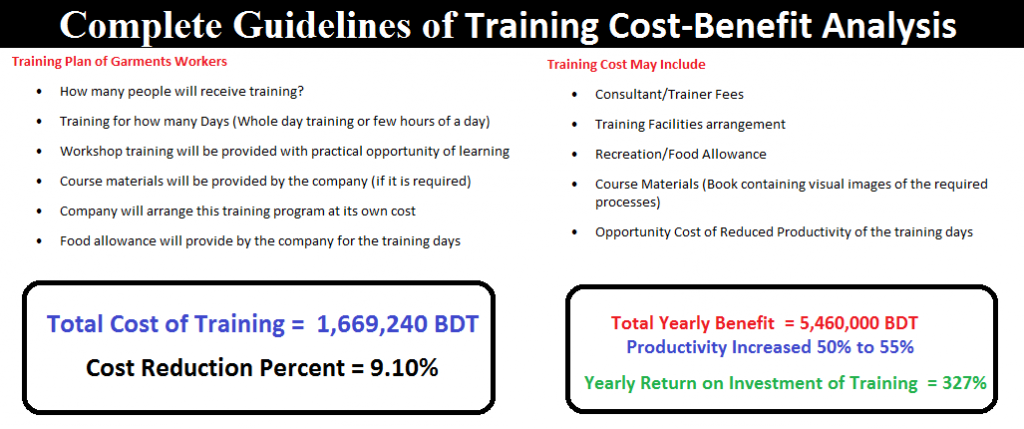This article will provide your complete training cost-benefit analysis of garment workers. Suppose 5000 workers are working in your factory. You are not able to reach the target productivity level. After a critical evaluation of the productivity of every worker, you have identified that 500 workers are performing below the expected level. The actual productivity is 50% for these 500 workers, which was estimated to be 65% on an average. And you also come to know that they have lower productivity because of a lack of skills and experience. You cannot just replace this large number of workers with skilled one because getting skilled workers is hard to find and a time-consuming process.
Complete Training Cost-Benefit Analysis of Workers

So it will be a better choice for you to provide the training, that will improve their skills, which results in increased productivity and lower in cost. But before that, you must do a cost-benefit analysis of investment for the training program and also calculate the return on investment. If you get a positive result, then you must go for the investment of the required training program.
A proper training plan and materials must be prepared by export from the related field, otherwise, your investment will become a loss project.
Training Plan of Garment Workers
To provide training you have to be ready with the following things
- How many people will receive training?
- Training for how many Days (Whole day training or few hours of a day)
- Workshop training will be provided with a practical opportunity of learning
- Course materials will be provided by the company (if it is required)
- Company will arrange this training program at its own cost
- Food allowance will provide by the company for the training days
Training Cost May Includes
- Consultant/Trainer Fees
- Training Facilities arrangement
- Recreation/Food Allowance
- Course Materials (Book containing visual images of the required processes)
- Opportunity Cost of Reduced Productivity of the training days
Calculation of Training Cost Benefit
Following parameters are required:
- Total number of worker will receive training = 500 person
- The training program will be for = 3 Days for each batch
- Number of hours of training = 8 Hours/Day
- The total training program will be for = 3 Days x 8 Hours = 24 Hours
- Total 50 people will receive training for 3 Days in a Batch
- Number of batch required = 500 Person/50 Person a day = 10 Batches
- Total Days Required for this training program is = 10 Batch x 3 days = 30 working days
- Number of Trainer = 2 Person
- Average Salary of Workers Per Month = 9,000 BDT/Month
- Total Working Hours in a Month = (8 Hours x 26 Days) = 208 Hours
- Average Salary of Workers Per Hour = (9,000 BDT/208 Hours) = 43.27 BDT/Hour
Cost Estimation of Training Program
- Total Consultancy/Trainer Fee = (30 Days x 20000 BDT) = 600,000 BDT
- Food Allowance = (500 Person x 3 Days x 100 BDT) = 150,000 BDT
- The cost of training facility arrangement = 300,000 BDT
- The cost of Training materials = 400,000 BDT
- Opportunity Cost of Losing Productive Hours = (500 Person x 3 Days x 8 Hours) = 12,000 Hours
- Total cost of Productive Hours = (12,000 Hours x 43.27 Average Hourly Salary) = 519,240 BDT
After summing up all these expenses, you will get the total cost of the above training program.
Total Cost of Training = (600,000 BDT + 150,000 BDT + 400,000 BDT + 519,240 BDT) = 1,669,240 BDT
Note:
- The training cost can vary industry to industry, training method to method.
- The training cost is highly depending on the scope of the training program.
- It is not necessary to provide food allowance and training course materials for the garments workers. But if you provide, then it will be beneficial for them. Although it is costly for most of the garments.
Calculation of Existing Productivity
Suppose if a factory can maintain 100% efficiency then a worker production capacity should be 1000 piece a day. You are expecting that your factory worker’s productivity should have 65%, which is 650 piece a day. But your factory running at 50% capacity, based on the production of 500 pieces a day.
- Expected Productivity = (650 Piece of Work /1,000 Piece of Work) = 65%
- Actual Productivity (Before Training) = (500 Piece of Work /1000 Piece of Work) = 50%
- Actual Productivity (After Training) = (550 Piece of Work /1000 Piece of Work) = 55%
Cost Benefit Analysis of Training Program
- Daily Production Will Increase for each worker = (550 Piece of Work – 500 Piece of Work) = 50 Piece of Work a Day
- Total Daily Increased Production = (50 Piece of Work x 500 Workers) = 25,000 Piece
- Total Monthly Increased Production = (25,000 Piece of Work x 26) = 650,000 Piece of Work in a Month
- Suppose a piece of work has a value of 0.070 BDT then total Benefit your factory will get = (650,000 Piece of Work x 0.70 BDT) = 455,000 BDT
- Total Yearly Benefit = (455,000 BDT x 12 Months) = 5,460,000 BDT
- Wages and Salary Expenses = (500 Worker x 9000 BDT) = 4,500,000 BDT
- Cost Per Operation (Before Training) = (4,500,000 BDT/ (500 Workers x 500 Piece a Day x 26 Days) = .692 BDT per Piece of Work
- Cost Per Operation (After Training) = (4,500,000 BDT/ (500 Workers x 550 Piece a Day x 26 Days) = .629 BDT Per Piece of Work
- Total Reduction of Cost per Piece of Work = (.692 BDT – .577 BDT) = .063 BDT
- Cost Reduction Percent = 9.10% because of increased productivity
Calculation of Return on Investment of Training Program
- Return on Investment of Training Program = (Yearly Total Benefit/Total Investment) x 100 = (5,460,000 BDT/1,669,240 BDT) x 100 = 327.09%
Calculation of Cost Benefit Ratio of Training
- Cost Benefit Ratio = (Yearly Total Benefit/Total Cost) = (5,460,000 BDT/1,669,240 BDT) = 3.27:1
That is, if you invest 1 BDT then you will receive benefit of 3.27 BDT which is more than three times of the investment amount.
Note:
- All numbers are taken assumption basis, so these numeric results are not 100% accurate to the apparel industry.
- BDT is used as a currency; you can use of your own currency.
Written by
Md. Nahian Mahmud Shaikat
Email: [email protected]

